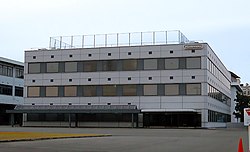

Nintendo's logotype, used during R&D2's existence
| |

Exterior of the former Nintendo headquarters in Kyoto, Japan, which housed the department
| |
Native name | 任天堂開発第二部 |
|---|---|
Romanized name | Nintendō Kaihatsu Daini Bu |
| Company type | Department |
| Industry | Video games |
| Genre |
|
| Predecessor | Nintendo Research & Development |
| Founded | 1978 |
| Founder | Hiroshi Yamauchi |
| Defunct | 2004 (2004) |
| Fate | Absorbed into Nintendo Software Planning & Development |
| Successor | Nintendo Software Planning & Development |
| Headquarters |
Kyoto
,
Japan
|
Number of locations | 1(Kyoto) (2004) |
Key people |
|
| Owner | Nintendo |
| Parent | Nintendo Manufacturing Division |
Nintendo Research & Development No. 2 Department,[a] commonly abbreviated as Nintendo R&D2, was a Japanese team within Nintendo that developed software and peripherals. While usually occupied in system operating software and technical support, the team would come back to early development in the 1990s where several new designers got their start at game development, the most famous being Eiji Aonuma who developed Marvelous: Another Treasure Island.
R&D2 was originally led by Masayuki Uemura, who previously worked for Sharp Corporation, using an idea of Sharp's solar technology Uemura's department went on to develop the popular Nintendo beam gun games, selling over 1 million units. Kazuhiko Taniguchi took Uemura's position in 2004. Nintendo R&D2 was later merged into Nintendo SPD.[1]
In the 1970s, Nintendo created the R&D2 department.[2]
In 2004, the department's general manager Masayuki Uemura retired from Nintendo.[3][4] Following his retirement, he became a professor at the Ritsumeikan University in Kyoto, and served as an advisor to Nintendo Research & Engineering.[5]
| Year | Name | Ref. |
|---|---|---|
| 1977 | Color TV-Game 6 | [6] |
| Color TV-Game 15 | [6] | |
| 1978 | Color TV-Game Racing 112 | [6] |
| 1979 | Color TV-Game Block Breaker | [6] |
| 1980 | Computer TV-Game | [6] |
| Year | Name | Ref. |
|---|---|---|
| 1983 | Family Computer | [6] |
| 1985 | Nintendo Entertainment System | [6] |
| 1990 | Super Famicom | [6] |
| 1991 | Super Nintendo Entertainment System | [6] |
| 1995 | Satellaview | [6] |
| Year | Title | Genre(s) | Platform(s) | Ref. |
|---|---|---|---|---|
| 1983 | Donkey Kong | Nintendo Entertainment System | [7] | |
| Donkey Kong Jr. | Nintendo Entertainment System | [7] | ||
| Mahjong | Nintendo Entertainment System | [7] | ||
| Donkey Kong Jr. Math | Nintendo Entertainment System | [7] | ||
| 1991 | NES Open Tournament Golf | Nintendo Entertainment System | [8][9] | |
| 1996 | Marvelous: Mōhitotsu no Takarajima | Super Famicom | [10] | |
| 1997 | BS Zelda no Densetsu: Inishie no Sekiban | Satellaview | [11] | |
| Sutte Hakkun | Satellaview | [12] | ||
| 1998 | Super Famicom | |||
| 1999 | Super Mario Bros. Deluxe | Game Boy Color | [13][9] | |
| 2000 | Kirby Tilt 'n' Tumble | Game Boy Color | [14] | |
| 2001 | Super Mario Advance | Game Boy Advance | [9] | |
| Super Mario World: Super Mario Advance 2 | Game Boy Advance | [9] | ||
| 2002 | The Legend of Zelda: A Link to the Past and Four Swords | Game Boy Advance | [9] | |
| Yoshi's Island: Super Mario Advance 3 | Game Boy Advance | [9] | ||
| 2003 | Super Mario Advance 4: Super Mario Bros. 3 | Game Boy Advance | [9] |
Masayuki Uemura: [...] Currently, he has a seat at Nintendo as an advisor in the Research and Engineering Department, and as a professor at Ritsumeikan University he researches video games and teaches students.
Due to the growing demand for development, he was in charge of the management of the Research & Development 2 Division in which they worked on the development of several hardware devices such as games for colour televisions, Nintendo Family Computer (Famicom), Nintendo Entertainment System (NES), Super Nintendo Entertainment System or BS-X Satellaview.
I worked on a wide variety of titles together with R&D2, including Donkey Kong, which was released at the same time as the Famicom, Donkey Kong Jr., Mahjong and Donkey Kong Jr. Math.
Producer: Masayuki Uemura
{{cite book}}: CS1 maint: numeric names: authors list (link)
Producer: Masayuki Uemura, Kazuhiko Taniguchi
{{cite book}}: CS1 maint: numeric names: authors list (link)
Producers: Masayuki Uemura, Kazuhiko Taniguchi
{{cite book}}: CS1 maint: numeric names: authors list (link)
|
| |||
|---|---|---|---|
| Divisions |
| ||
| Subsidiaries |
| ||
| Major affiliates |
| ||